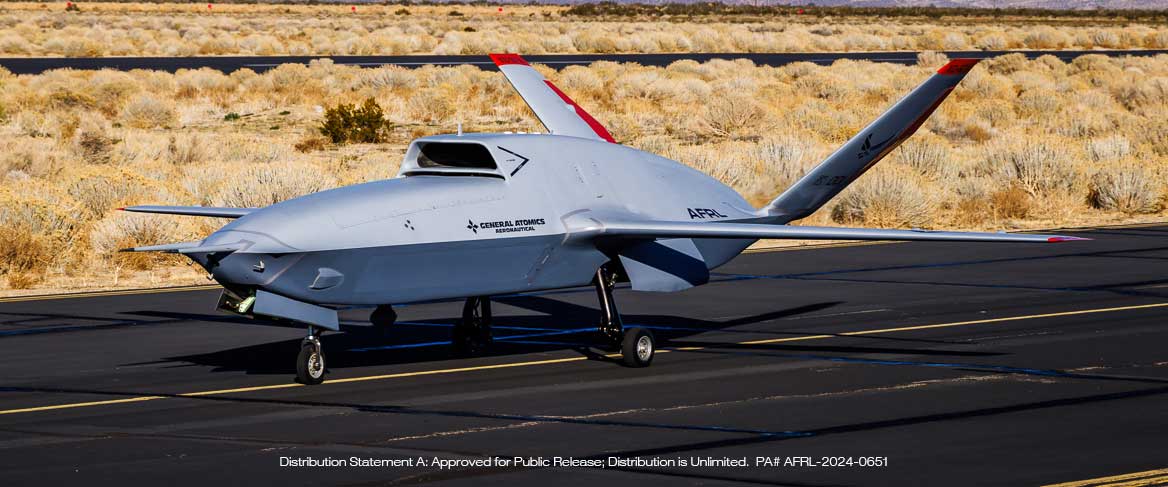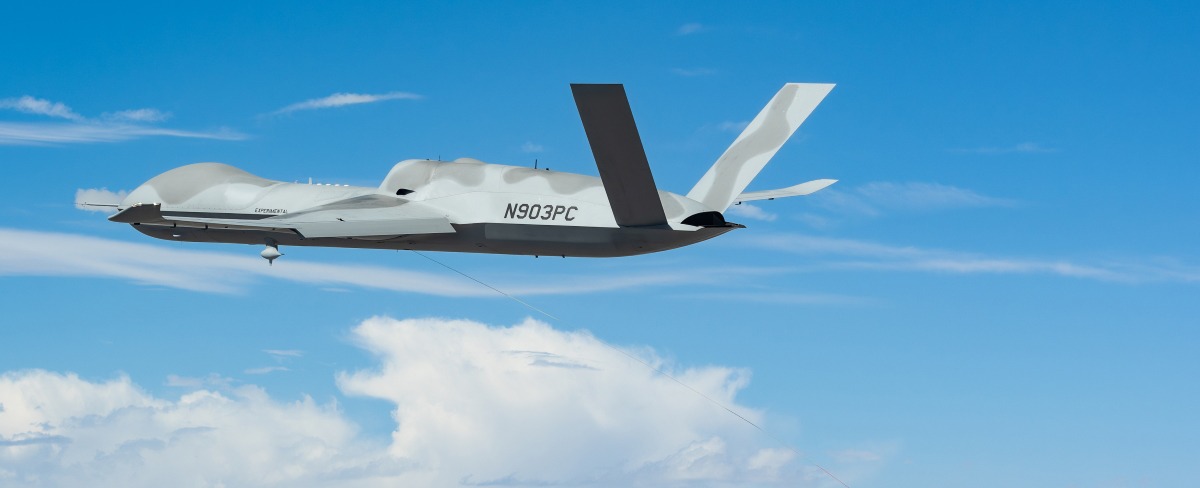The U.S. Air Force Research Laboratory’s (AFRL) Aerospace Systems Directorate successfully flew the XQ-67A, an uncrewed air vehicle (UAV), on 28 February at the General Atomics’ Gray Butte flight operations facility near Palmdale, California.
Earlier, the XQ-58A Valkyrie became the first low-cost UAV intended to provide the airfighter with a credible and affordable aerial platform with multitasking capabilities. The projects are part of the Low-Cost Attritable Aircraft Platform Sharing (LCAAPS) and Off-Board Sensing Station (OBSS) programs, the concept work for which began in late 2014.
On 23 July 2020, USAF gave demonstration contracts to Kratos, Boeing, Northrop Grumman, and General Atomics as part of their Skyborg program, an effort to field an uncrewed wingman for crewed fighters, at a price that could make them expendable. Northrop was eliminated in December 2020. Kratos, Boeing, and General Atomics delivered their entries by May 2021 for flight tests in July 2021.
Kratos XQ-58 Valkyrie
The Kratos XQ-58 Valkyrie is an underdevelopment experimental stealthy uncrewed combat aerial vehicle (UCAV) designed and built by Kratos Defence & Security Solutions for the USAF’s Low-Cost Attritable Strike Demonstrator (LCASD) program under the USAF AFRL LCAAPS project portfolio.
It was initially designated the XQ-222. The Valkyrie completed its first flight on 5 March 2019 at Yuma Proving Ground, Arizona. At the time, it was said that this stealthy AI drone could be the military’s next weapon.
The stealth XQ-58 features a trapezoidal fuselage with a chinned edge, a V-tail, and an S-shaped air intake. The 30 ft long, 27 ft wingspan, and 2700 kilogram all-up weight platform could carry 272 kg each internally and on external stations. The cruise speed was over 850 km/h, with a range of 5,600 km and a service ceiling of 45,000 ft.
The Valkyrie XQ-58A is a combat drone designed to deliver weapons or assist fighter jets. The prototype was under development for years. Using AI, it can perform tasks autonomously and take on advanced adversaries. The platform is meant for the US Air Force (USAF) and the United States Marine Corps (USMC).
It can operate as part of a swarm of drones, with or without direct pilot control. The XQ-58 can make conventional take-offs and landings or be launched from a variety of launch modules, including support ships, shipping containers, and semi-trailer trucks.
It is meant to act as a loyal wingman controlled by a parent aircraft to accomplish tasks such as scouting, defensive fire, or absorbing enemy fire. It is also meant to escort the F-22 or F-35 during combat missions, provide surveillance of the battle zone ahead, and deploy weapons.
Kratos had said that the company could produce 250 to 500 Valkyries per year. The unit cost was to be $4 million at an annual production rate of 50 aircraft and possibly for less than $2 million if over 100 airframes were built per year. For reference, a 4th to 5th-gen fighter costs around $80-100 million.
The XQ-58A completed its sixth test flight, opening the doors of its internal weapons bay for the first time and releasing a 12 kg Area-I Altius-600 small uncrewed aircraft system (UAS).
In August 2023, pictures showed the XQ-58A in formation with an F-15E Strike Eagle. In December 2022, the USMC ordered two XQ-58s for testing for their Penetrating Affordable Autonomous Collaborative Killer – Portfolio (PAACK-P) program and conducted the first test in October 2023. In January 2023 the United States Navy (USN) ordered two XQ-58s for tests similar to those being undertaken by the Marines.
General Atomics XQ-67A
The basic concepts having been proven on the XQ-58, in 2023, General Atomics Aeronautical Systems, Inc. (GA-ASI) ‘s XQ-67A was chosen to advance the second generation of autonomous collaborative platforms.
It is an experimental uncrewed vehicle funded by the AFRL and designed with a common chassis to be affordable and rapidly replicated. The approach reduced the risk in the development of future generations.
Advancements in manufacturing technology were brought in. The XQ-67A proves the common chassis or “genus” approach to aircraft design. One doesn’t have to start from scratch.
This approach speeds development, delivery, and affordability by leveraging standard substructures and subsystems, similar to how the automotive industry builds a product line. It affords the possibility of adding different avionics and weapon kits to the aircraft frame. New models can be developed and rolled out every few years.
Therefore, the XQ-67A took just over two years to make. It combines autonomy, human systems integration, sensor and weapons payloads, networks and communications, and the air vehicle.
The XQ-67A tries to meet the combined requirements of sensor carriage, longer range, and endurance, meshing them with improved speed and maneuverability. The intention was to augment, not replace, crewed aircraft.
GA-ASI said they were focused on speed to ramp, accelerated design processes, and bringing true capability to the fight. They said we would discuss the deep details about the airplane very soon.
Manned Unmanned Teaming (MUM-T)
The maturing of uncrewed aerial systems, autonomous operations using Artificial Intelligence (AI), and more reliable, secure data links have made it possible to combine the missions of crewed and uncrewed aerial platforms.
This coupling helps ensure accuracy, operational flexibility, and continuity of machine learning. Incorporating uncrewed autonomous systems into mission planning expands mission parameters without exposing the more expensive crewed aircraft and the airborne crew to a high-threat environment; the uncrewed wingmen could perform Intelligence Surveillance Reconnaissance (ISR) or tactical early warning missions and Suppression of Enemy Air Defences (SEAD).
The low-cost design allows operators to confidently deploy it on the front line. Wingmen platforms could be as large as a small fighter, have fighter-like performance, fly long ranges, and have high endurance. Integrated sensor packages on board could support many missions. They could even carry weapons. They could fly in a variety of formations and perform coordinate maneuvers.

Loyal Wingman Concept
The Kratos XQ-58A and the XQ-67A are part of the USAF’s Loyal Wingman Concept. These will fly in coordination with other crewed combat aircraft. Also in the package could be much smaller platforms (drones) like Gremlins, which could be launched from the ground, fighters, or from a transport aircraft like the C-130.
After multi-hour test flights in the Skyborg-equipped unmanned aerial vehicle (UAV), two General Atomics MQ-20 Avenger UAVs demonstrated in-flight communication between each other and “responded to navigational commands, stayed within specified geo-fences, and maintained flight envelopes,” while monitored from the ground command and control station.

The Loyal Wingmen are planned to be paired with the USAF’s Next-Generation Air Dominance (NGAD) fighter. Wingmen have also been tested in aerial refueling and cargo roles.
Operational Employability
Operational applications of the Loyal Wingman for combat support operations and precision targeting are well established. Typically around five UCAVs would be controlled by a single modern crewed fighter aircraft.
The forward-flying wingmen would broaden the mother aircraft’s situational awareness using optical, infrared, electromagnetic, or radar sensors. They would also map out the target area, identify the location of radars and air defense systems, and clear the corridor for the crewed aircraft.
The crewed aircraft would assess the operational environment and situational awareness and assign tasks to the loyal wingmen. The physical tactical formation position of all aircraft would depend on the type of mission.
The loyal wingmen could also serve as communications nodes for friendly forces or conduct electronic warfare operations by jamming enemy radars, communications, or other signals.
A few may carry their own weapons and carry out air-to-air or air-to-ground strikes alongside the crewed aircraft, giving the enemy multiple threats to counter. They could serve as decoys to befuddle the enemy.
A SEAD and Strike combination could mean the loyal wingmen flying nearly 5-7 minutes ahead of the strike and destroying AD systems using precision-guided air-to-surface weapons.
They could also carry air-to-air missiles and directed energy weapons to target enemy fighters or electronics. Unmanned wingmen could also target enemy airfields, army installations, radar sites, and surface-to-air missile launchers.
A whole bunch of opportunities are possible. The exact mix of manned and unmanned aircraft and what types of sensors and weapons the UAVs would carry would have to be mission-specific.
Some actions would be pre-programmed into the uncrewed aircraft. In the air, the mother aircraft could change the course of action. The two have to operate in conjunction, not necessarily in the near vicinity. The concept is highly technology—and communication-link-dependent.
Threats To Loyal Wingmen Teaming
The adversary could disrupt the formation communications and, therefore, will need levels of autonomy that allow the Wingman to carry out their assigned missions. In such a contingency, their autonomous operations could be limited in terms of timing, geographic reach, and missions, which would have to be programmed.
Also, contingencies of autonomous system misbehavior would need a protocol or a “get home” command and system. If a threat emerges, autonomous evasive actions would need programming. The ethical questions of conducting warfare and potentially killing humans with autonomous devices must be addressed.
Way Ahead India
Hindustan Aeronautics Ltd (HAL) is leading the initial Wingmen-related experimentation with its proposed LCA-based CATS in collaboration with a Bengaluru-based start-up, Newspace Research & Technologies.
It will involve a recoverable wingman till the combat radius of 350 km. The range would increase to 800 km for a kamikaze attack on target.
The CATS Warrior (CW) autonomous wingman would be capable of take-off and landing from land and sea from an aircraft carrier. It will team up with the existing fighter platforms of the IAF, like Tejas, Su-30 MKI, and Jaguar, which will act like its mothership.
The initial design has a composite structure that looks like a combination of the Boeing Airpower Teaming System wingman (MQ-28A “Ghost Bat”) and the XQ-58. It will be powered by a modified HAL PTAE-7 or HAL HTFE-25 turbofan engine.
One day, the CW would be equipped with suitable ISR/ EW payloads and air-to-air missiles or air-to-ground weapons. The CW itself could launch up to 24 ALFA-S swarm drones. It will be equipped with an electro-optic/infrared payload, active electronically scanned array (AESA) radar, inertial navigational unit, and jammer for intelligence, surveillance and reconnaissance, and combat operations.
In the long run, the wingman could be on an upgraded Jaguar fighter (some call it the Jaguar Max) or an SU-30 MKI, both of which are in large numbers with the IAF.
China and Russia are also working on the Wingman concept. Russia’s S-70 Okhotnik-B (Hunter) is a stealth-capable combat drone that will team with the fifth-generation Su-57.
The Indian drone industry is also growing rapidly. The future is mostly unmanned or optionally manned. India must get its act right through collaboration between the public and private sectors. It has the potential to become a global hub, but it would have to show urgency and national commitment.
- Air Marshal Anil Chopra (Retired) is an Indian Air Force veteran fighter test pilot and is currently the Director-General of the Center for Air Power Studies in New Delhi. He has been decorated with gallantry and distinguished service medals while serving in the IAF for 40 years. He tweets @Chopsyturvey
- Follow EurAsian Times on Google News




